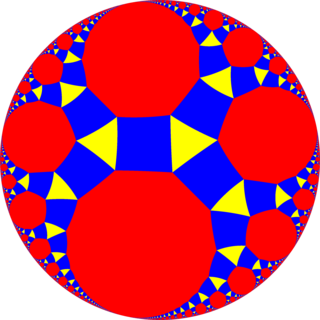Top Qs
Timeline
Chat
Perspective
Rhombitriapeirogonal tiling
From Wikipedia, the free encyclopedia
Remove ads
In geometry, the rhombtriapeirogonal tiling is a uniform tiling of the hyperbolic plane with a Schläfli symbol of rr{∞,3}.
| Rhombitriapeirogonal tiling | |
|---|---|
 Poincaré disk model of the hyperbolic plane | |
| Type | Hyperbolic uniform tiling |
| Vertex configuration | 3.4.∞.4 |
| Schläfli symbol | rr{∞,3} or s2{3,∞} |
| Wythoff symbol | 3 | ∞ 2 |
| Coxeter diagram | |
| Symmetry group | [∞,3], (*∞32) [∞,3+], (3*∞) |
| Dual | Deltoidal triapeirogonal tiling |
| Properties | Vertex-transitive |
Remove ads
Symmetry
This tiling has [∞,3], (*∞32) symmetry. There is only one uniform coloring.
Similar to the Euclidean rhombitrihexagonal tiling, by edge-coloring there is a half symmetry form (3*∞) orbifold notation. The apeireogons can be considered as truncated, t{∞} with two types of edges. It has Coxeter diagram ![]()
![]()
![]()
![]()
![]() , Schläfli symbol s2{3,∞}. The squares can be distorted into isosceles trapezoids. In the limit, where the rectangles degenerate into edges, an infinite-order triangular tiling results, constructed as a snub triapeirotrigonal tiling,
, Schläfli symbol s2{3,∞}. The squares can be distorted into isosceles trapezoids. In the limit, where the rectangles degenerate into edges, an infinite-order triangular tiling results, constructed as a snub triapeirotrigonal tiling, ![]()
![]()
![]()
![]()
![]() .
.
Remove ads
Related polyhedra and tiling
Symmetry mutations
This hyperbolic tiling is topologically related as a part of sequence of uniform cantellated polyhedra with vertex configurations (3.4.n.4), and [n,3] Coxeter group symmetry.
Remove ads
See also
Wikimedia Commons has media related to Uniform tiling 3-4-i-4.
References
External links
Wikiwand - on
Seamless Wikipedia browsing. On steroids.
Remove ads




























